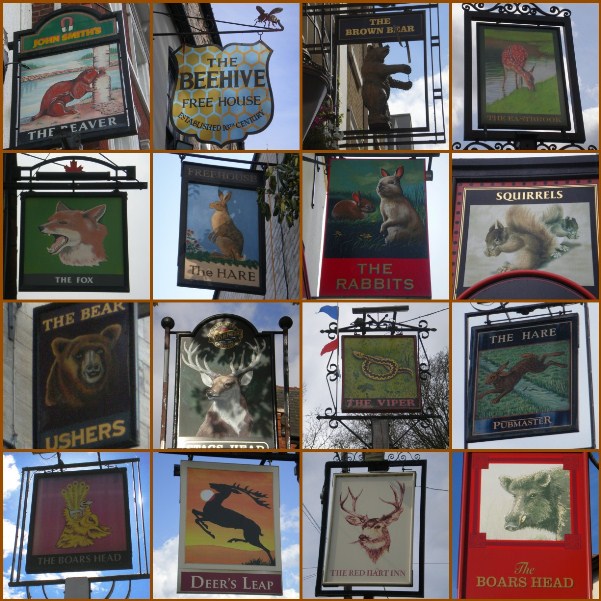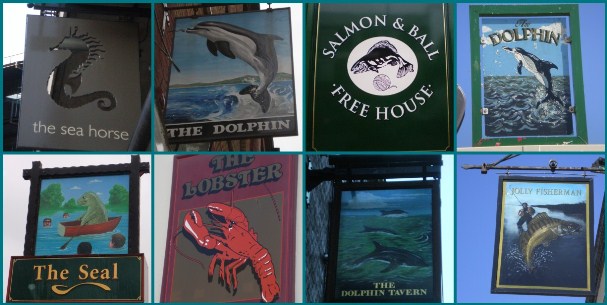by Esmerelda Weatherwax (June 2011)
One of the most popular types of pub sign features animals. There are so many of these I’m just featuring English wildlife on land, in water and the farm yard this month. Dogs (and a few cats) horses, and exotic animals could be a month’s articles on their own. And probably will, one month.
English wildlife.
These are, left to right, top to bottom.

The Beaver, Beverley Yorkshire.
The beaver has been extinct in Great Britain for 500 years but has been reintroduced into the wild under controlled conditions in England and Scotland and a trial in Wales is proposed. The nature conservationists are optimistic but farmers are wary. The town of Beverley in Yorkshire was renamed Beverlac, meaning Beaver lake or clearing, a reference to the colonies of beavers along the River Hull in the 10th century.
The Beehive Grantham Lincolnshire.
Home of the living sign, which I wrote about here in December. Bees may have been better filed under farmyard animals but they roam free so I kept them here.
The Brown Bear, Stepney.
Bears have been extinct in the British Isles for a very long time – some think since before the Romans came. This may have been a dancing bear kept for sport and entertainment in the Middles Ages.
The Eastbrook Dagenham.
A fawn drinking near the edge of the Chase Nature Reserve. A reminder that Dagenham was only industrialised 80 years ago.
The Fox at Rivenhall.
The name always reminded me of places from Lord of the Rings. The first time I went in I half expected the interior of the Prancing Pony. But there were no hobbits, no mysterious ranger who was really Aragorn future First High King of the Reunited Kingdom, only a television tuned to BBC football for a Saturday afternoon. Sadly closed and recently sold. I don’t know who the buyer is and what the plans are.
The Hare, Bethnal Green; The Rabbits, Grays;
The Squirrels, Gidea Park, also closed and supposed to reopen as an Indian restaurant.
The Bear, Bradford on Avon Wiltshire has been closed and boarded up for several years.
The Stag’s Head, Lincoln; The Viper, Ingatestone; The Hare, Lanivet Bishops near Chelmsford;
The Boar’s Head, Ingatestone; The Deer’s Leap, Thetford; The Red Hart, Bodham Norfolk; The Boar’s Head, Dunmow.
The Wild Boar was hunted to extinction during the Middle Ages but several have escaped from captivity in recent years and are believed to be breeding in the wild happily again.
Deer, stags, harts and hinds (male and female) are very common, both as relics of the hunt and as heraldic badges. The Red Hart at Bodham is unusual in being of a naturalistic red deer. Hinds are less common, other than a few Golden Hinds, named after the ship and the White Hart which was the emblem of King Richard II. The Hind’s Head in Dagenham has been closed for a long time and its sign is now missing.
Five examples of the White Hart are below, from Billericay, Swaffham, Whitechapel, Grays and West Smithfield.

Water creatures are also popular, both fresh and sea water.

The Sea Horse, London EC4; sea horses are breeding off the south coast, in particular at Studland Bay.
The Dolphin, King’s Cross, a lovely old fashioned back street pub.
The Salmon and Ball, Bethnal Green. Famous landmark opposite St John’s church, just round the corner from Anjem Choudary’s former HQ and once part owned by Bobby Moore. For a time it was sacrilegiously renamed ‘Tipples’.
The Dolphin, Hastings.
The Seal, Woodbridge. This is (was) one of my favourite signs. The Seal was a relatively new pub just outside Woodbridge in Suffolk which felt old because it was built largely out of reclaimed brick, timber and stone. It used to be a pub that served good meals. It changed hands earlier this year and is now called the Duke of York, and runs as a restaurant which has a small bar. This is happening a lot, and while it is better than the pub being demolished or converted into offices, because the balance of restaurant to bar can be changed, the atmosphere is different, and somehow never so friendly.
I have forgotten whether it is the Red deer or the Grey seal that is the largest mammal found in the British Isles; they are both a lot larger than me.
The Lobster, Sheringham. There is quite a rivalry, not always friendly, between the two coastal resorts Sheringham and Cromer. Cromer is particularly noted for crabs; therefore Sheringham has to celebrate the Lobster. There isn’t a pub in Cromer called the Crab, and the Dolphin there hasn’t a sign.
The Dolphin Tavern, London WC1. I always thought that Dolphins were an exotic Mediterranean creature but they are common in British waters. I just have never seen one. I have seen plenty of seals off the east coast, however.
The Jolly Fisherman, Barking. According to my husband the fisherman is jolly because he has just caught either a perch or a zander; the depiction is too stylised to be definite. I could have included the Fish and Eels at Hoddesdon but that sign concentrates more on the fisherman’s boat and his catch can hardly be seen.
The Farmyard

The Hog in the Pound, London W1. Just off Oxford Street, handy for Selfridges.
The Lamb, Castle Donington, handy for East Midlands airport and the racetrack. The Ram, Hertford.
The Old Red Cow, opposite Smithfield meat market London. The Spotted Bull, St Albans.
The Goat Tavern, Mayfair. The Dun Cow, Salthouse Norfolk. Magnificent view across the creeks and saltmarsh.
Bull and Chain, Lincoln; The Bull, Dagenham as it was in 2009. The pub closed, was refitted and reopened with a different, plainer, sign.
The Blue Pig, Grantham. I don’t know why it’s blue. The blue boar was the emblem of the Earl of Oxford; perhaps this is the Blue Boar’s companion.
The Kicking Dickey in Dunmow, Essex. A Dickey is a donkey. According to Webster’s dictionary “Dickey or Dicky. A donkey; anciently called a Dick-ass, now termed Jack-ass. It is a term of endearment”. I didn’t know that about the dick-ass. I don’t think I will say any more. The name seems to be unique although there is a Kick and Dicky in Ware which is about 20 miles away in Hertfordshire. Donkeys can be difficult creatures.
Ye Olde Black Bull, Stratford E15 (atte Bow, not upon Avon); The Bull, Barking; The Bull, Fakenham; The Lamb, Romford. All places that had cattle markets.
The Pig Inn the City, Gloucester. A fine Gloucestershire Old Spot, aka the Orchard pig.
The Plough, Gainsborough. Although I am collecting horses separately a farm isn’t complete without at least one plough-horse.
The Bull, Bishopsgate London EC1; The Bull, Corringham Essex.
And there’s more. I find a new one nearly every time I go out any distance.
To comment on this article, please click here.
If you enjoyed this piece and would like to read more by Esmerelda Weatherwax, please click here.
To help New English Review continue to publish articles such as this one, please click here.
Esmerelda Weatherwax is a regular contributor to the Iconoclast, our community blog. To view her entries please click here.
- Like
- Digg
- Tumblr
- VKontakte
- Buffer
- Love This
- Odnoklassniki
- Meneame
- Blogger
- Amazon
- Yahoo Mail
- Gmail
- AOL
- Newsvine
- HackerNews
- Evernote
- MySpace
- Mail.ru
- Viadeo
- Line
- Comments
- SMS
- Viber
- Telegram
- Subscribe
- Facebook Messenger
- Kakao
- LiveJournal
- Yammer
- Edgar
- Fintel
- Mix
- Instapaper
- Copy Link







